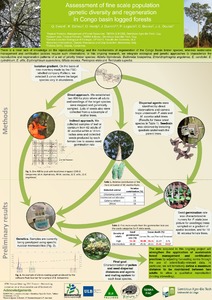Resource information
In the Congo Basin most of the light-demanding timber tree species display a deficit of natural regeneration which is a major handicap for sustainable production and certification. Whilst the majority of scientists investigate abiotic and biotic factors explaining that pattern, we hypothesize that tree population density or individual spatial isolation may also affect the tree fitness through inbreeding. In this study, we integrate ecological and genetic approaches to characterize the regeneration potential of a set of priority timber species by (i) estimating pollen dispersal distances at various tree population densities, and (ii) evaluating the impact of increasing spatial isolation on mating characteristics and tree fitness. The ultimate goal is the proposal of minimum population density that prevents inbreeding consequences.
Method
This ongoing study focuses on 10 timber species (Pericopsis elata, Milicia excelsa, Baillonella toxisperma, Entandrophragma cylindricum, E. utile, E. angolense, E. candollei, Afzelia bipindensis, Erythrophleum suaveloens, Terminalia superba). The data collection was carried out in the logging concession granted to Pallisco in Cameroon.
We established two 400-ha plots, where all individuals (DBH > 10 cm) of the target species were inventoried and mapped. A sample of leave or cambium was collected for each of these individuals, as well as for seedlings to characterize patterns of gene flow using genetic tools (nuclear microsatellites). Dispersal agents were identified by direct observations and camera traps. Germination success was characterized in nursery for seeds collected on trees under an increasing isolation gradient.
Results
Main dispersal agents (wind, bat, rodent) and predators (rodent) were identified for all the species. The gene flow and germination data is still being analyzed and the main results will be presented in the poster.
Conclusion
Our data will allow characterizing the reproductive biology of a set of important timber species from the Congo basin. These information will strengthen sustainable forest management and the application of certification by adjusting harvesting norms through the use of scientifically-relevant data. In particular, we will tentatively define a maximum distance to be maintained between two adults to allow a qualitative reproduction.


